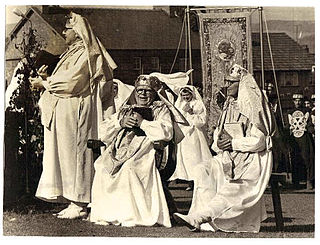This page is based on this
Wikipedia article Text is available under the
CC BY-SA 4.0 license; additional terms may apply.
Images, videos and audio are available under their respective licenses.
Owain ap Gruffudd was King of Gwynedd, North Wales, from 1137 until his death in 1170, succeeding his father Gruffudd ap Cynan. He was called "Owain the Great" and the first to be styled "Prince of Wales". He is considered to be the most successful of all the North Welsh princes prior to his grandson, Llywelyn the Great. He became known as Owain Gwynedd to distinguish him from the contemporary king of Powys Wenwynwyn, Owain ap Gruffydd ap Maredudd, who became known as Owain Cyfeiliog.

Gruffudd ap Cynan, sometimes written as Gruffydd ap Cynan, was King of Gwynedd from 1081 until his death in 1137. In the course of a long and eventful life, he became a key figure in Welsh resistance to Norman rule, and was remembered as King of all Wales. As a descendant of Rhodri Mawr, Gruffudd ap Cynan was a senior member of the princely House of Aberffraw.

The Principality or Kingdom of Gwynedd was a Roman Empire successor state that emerged in sub-Roman Britain in the 5th century during the Anglo-Saxon settlement of Britain.
Cadwallon is a Welsh name derived from the Common Brittonic *Katuwellaunos "The One Who (-mnos) Leads (welnā-) in Battle (katu-)". The same name belonged to the Catuvellauni who lived in what is now Hertfordshire, one of the most powerful British polities in the Late Iron Age who led the resistance against the Romans in 43 CE and possibly against Caesar in 55 and 54 BCE as well.

The Kingdom of Powys was a Welsh successor state, petty kingdom and principality that emerged during the Middle Ages following the end of Roman rule in Britain. It very roughly covered the top two thirds of the modern county of Powys and part of the West Midlands. More precisely, and based on the Romano-British tribal lands of the Ordovices in the west and the Cornovii in the east, its boundaries originally extended from the Cambrian Mountains in the west to include the modern West Midlands region of England in the east. The fertile river valleys of the Severn and Tern are found here, and this region is referred to in later Welsh literature as "the Paradise of Powys".

Hywel ab Owain Gwynedd, Wales Prince of Gwynedd in 1170, was a Welsh poet and military leader. Hywel was the son of Owain Gwynedd, prince of Gwynedd, and an Irishwoman named Pyfog. In recognition of this, he was also known as Hywel ap Gwyddeles. Hywel was also known as the Poet Prince for his bardic skills.
Trahaearn ap Caradog was a King of Gwynedd. Trahaearn was a son of Caradog ap Gwyn, ruler of Arwystli, a small state, on the south-western border between Gwynedd and Powys. He was born in 1044 in Arwystli, and died in 1081 in Mynydd Carn in Pembrokeshire, at the Battle of Mynydd Carn.

Maredudd ab Owain was a 10th-century king in Wales of the High Middle Ages. A member of the House of Dinefwr, his patrimony was the kingdom of Deheubarth comprising the southern realms of Dyfed, Ceredigion, and Brycheiniog. Upon the death of his father King Owain around AD 988, he also inherited the kingdoms of Gwynedd and Powys, which he had conquered for his father. He was counted among the Kings of the Britons by the Chronicle of the Princes.
Maredudd ap Bleddyn was a prince and later King of Powys in eastern Wales.
Gruffudd ap Cynan ab Owain Gwynedd was the grandson of Owain Gwynedd a famous king of Gwynedd and ruler of most of Wales in the 12th century. The longer patronymic form of his name is usually used to distinguish him from the earlier and better-known Gruffudd ap Cynan, king of Gwynedd.
This article is about the particular significance of the century 1101 - 1200 to Wales and its people.
This article is about the particular significance of the century 901 - 1000 to Wales and its people.
The House of Aberffraw is a historiographical and genealogical term historians use to illustrate the clear line of succession from Rhodri the Great of Wales through his eldest son Anarawd.

Tegeingl, in English; Englefield, was a cantref in north-east Wales during the mediæval period. It was incorporated into Flintshire following Edward I of England's conquest of northern Wales in the 13th century.
Owain ab Edwin of Tegeingl or Owain Fradwr was lord of the cantref of Tegeingl in north-east Wales at the end of the 11th century. He was the son of Edwin of Tegeingl. He sided with the Normans in their failed invasion of North Wales, and in the 1090s attempted to become ruler of Gwynedd.
Angharad ferch Owain (1065–1162) was the wife of Gruffudd ap Cynan, a king of Gwynedd.
Cadwallon ap Gruffydd was the eldest son of Gruffudd ap Cynan, king of Gwynedd.






